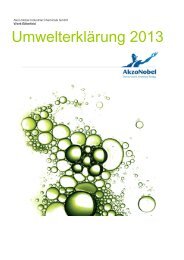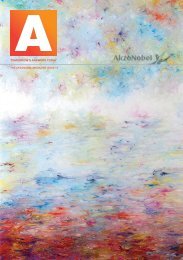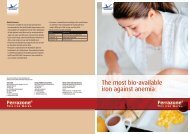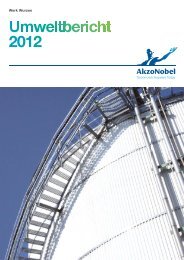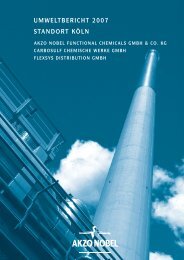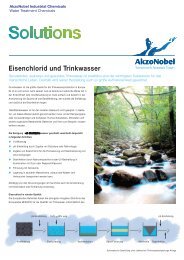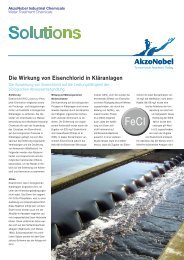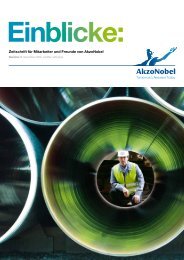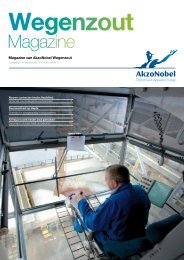Photodegradation of rhodamine B in aqueous solution ... - AkzoNobel
Photodegradation of rhodamine B in aqueous solution ... - AkzoNobel
Photodegradation of rhodamine B in aqueous solution ... - AkzoNobel
You also want an ePaper? Increase the reach of your titles
YUMPU automatically turns print PDFs into web optimized ePapers that Google loves.
20 P. Wilhelm, D. Stephan / Journal <strong>of</strong> Photochemistry and Photobiology A: Chemistry 185 (2007) 19–25<br />
the surface <strong>of</strong> the catalyst, the SiO2@TiO2 core–shell system is<br />
cheaper than pure titania as the <strong>in</strong>ert silica core is well available<br />
as <strong>in</strong>dustrial by-product.<br />
Rhodam<strong>in</strong>e B is used as model organic dye, as it is the most<br />
important xanthene dye and dye pollutants from the textile <strong>in</strong>dustry<br />
are an important factor <strong>in</strong> environmental pollution and its<br />
degradation mechanism has been studied quite well [24–26].<br />
The photodegradation <strong>of</strong> <strong>rhodam<strong>in</strong>e</strong> B <strong>in</strong> <strong>aqueous</strong> <strong>solution</strong> via<br />
coated spheres was <strong>in</strong>vestigated by UV–vis spectroscopy and<br />
determ<strong>in</strong>ation <strong>of</strong> the total organic carbon (TOC).<br />
2. Experimental<br />
2.1. Preparation <strong>of</strong> SiO2@TiO2<br />
SiO2@TiO2 [19,27,28] was synthesized through heterocoagulation<br />
<strong>of</strong> silica spheres and titania nanosol. The silica particles<br />
were synthesized accord<strong>in</strong>g to the method described by Stöber et<br />
al. [20]. To obta<strong>in</strong> particles <strong>in</strong> different sizes, the concentration<br />
<strong>of</strong> the used reagents was varied. Titania sol was prepared by a<br />
hydrolysis–condensation reaction <strong>of</strong> tetrapropylorthotitanate <strong>in</strong><br />
ethanol as solvent. To peptize the <strong>in</strong>termediate gel, hydrochloric<br />
acid was added to the <strong>solution</strong> [21]. The coat<strong>in</strong>g was performed<br />
by gradual addition <strong>of</strong> titania sol to silica particles dispersed<br />
<strong>in</strong> ultra-pure water. The coat<strong>in</strong>g progress was monitored by<br />
zeta potential measurements. After complete coat<strong>in</strong>g <strong>of</strong> the silica<br />
particles, excess titania was removed through centrifugation<br />
(10,000 g, 10 m<strong>in</strong>) and discard<strong>in</strong>g the supernatant. The coated<br />
particles were then redispersed <strong>in</strong> ultra-pure deionized water.<br />
More details about the preparation are given elsewhere [19].<br />
2.2. Characterization <strong>of</strong> SiO2@TiO2<br />
The size <strong>of</strong> titania, silica and coated silica was measured<br />
us<strong>in</strong>g acoustic attenuation spectroscopy. The zeta potential <strong>of</strong><br />
the particles was calculated from the colloidal vibration current<br />
(CVI) determ<strong>in</strong>ed by electroacoustic measurements [29]. Both<br />
methods were performed by us<strong>in</strong>g a DT 1200 from Dispersion<br />
Technology. The phase composition <strong>of</strong> titania nano-particles<br />
was determ<strong>in</strong>ed us<strong>in</strong>g Rietveld ref<strong>in</strong><strong>in</strong>g techniques with the fundamental<br />
parameter approach (Bruker AXS, Topas 2.1). The<br />
morphologies <strong>of</strong> silica and SiO2@TiO2 were <strong>in</strong>vestigated by<br />
scann<strong>in</strong>g electron microscopy studies (SEM) (Philips XL 30<br />
ESEM FEG).<br />
2.3. <strong>Photodegradation</strong> <strong>of</strong> <strong>rhodam<strong>in</strong>e</strong> B<br />
The photodegradation <strong>of</strong> <strong>rhodam<strong>in</strong>e</strong> B (RB) was <strong>in</strong>vestigated<br />
us<strong>in</strong>g a Suntest CPS+ from Atlas Material Test<strong>in</strong>g Solutions<br />
as source for artificial sunlight. The applied radiation <strong>in</strong>tensity<br />
for the experiments was 550 W/m 2 , which is equivalent to the<br />
solar <strong>in</strong>tensity at high noon <strong>in</strong> the equatorial region. The test<br />
was performed with 100 mL <strong>of</strong> water conta<strong>in</strong><strong>in</strong>g 10 −5 mol/L<br />
RB and 1.5·10 −3 wt% titania and dispersed SiO2@TiO2, respectively.<br />
The mixture was irradiated at the described <strong>in</strong>tensity and<br />
the progress <strong>of</strong> the degradation <strong>of</strong> <strong>rhodam<strong>in</strong>e</strong> B was monitored<br />
every hour by UV–vis spectroscopy (Varian Cary 50). In order<br />
to quantify the concentration <strong>of</strong> <strong>rhodam<strong>in</strong>e</strong> B, the UV–vis spectrometer<br />
was calibrated to a concentration range between 10 −7<br />
and 10 −5 mol/L at a wavelength <strong>of</strong> 554 nm, which corresponds<br />
to the absorption maximum <strong>of</strong> RB. As a reference measurement<br />
100 mL <strong>of</strong> water with 10 −5 mol/L RB was also irradiated and<br />
monitored by UV–vis spectroscopy to <strong>in</strong>vestigate if degradation<br />
also occurs <strong>in</strong> the absence <strong>of</strong> the photocatalyst.<br />
Additionally, TOC <strong>in</strong> the mixture was determ<strong>in</strong>ed by us<strong>in</strong>g a<br />
highTOC II from Elementar Analysensysteme <strong>in</strong> order to <strong>in</strong>vestigate<br />
if the dye is only photobleached or completely degraded.<br />
For these <strong>in</strong>vestigations, a <strong>solution</strong> <strong>of</strong> 75 mL 4·10 −5 mol/L RB<br />
plus 75 mL titania sol was used. This <strong>solution</strong> was also irradiated<br />
at the described conditions except for the fact that the UV<br />
filter was removed from the Suntest CPS+ <strong>in</strong> order to accelerate<br />
the degradation reaction as UV rays up to a wavelength <strong>of</strong><br />
250 nm are applied to the system. Samples at the beg<strong>in</strong>n<strong>in</strong>g, <strong>in</strong><br />
the middle and at the end <strong>of</strong> the experiment were taken for TOC<br />
analysis.<br />
3. Results and discussion<br />
3.1. Characteristics <strong>of</strong> SiO2@TiO2<br />
The size <strong>of</strong> the titania nanosol was 10 nm accord<strong>in</strong>g to acoustic<br />
attenuation measurements. Its isoelectric po<strong>in</strong>t (IEP) determ<strong>in</strong>ed<br />
by zeta potential measurements is at pH 6.7 (Fig. 1).<br />
Besides that X-ray diffraction (XRD) studies were made to determ<strong>in</strong>e<br />
the phase composition via Rietveld quantification. These<br />
studies revealed anatase as major phase and rutile as m<strong>in</strong>or<br />
phase. Exact quantification was not possible due to the lack <strong>of</strong><br />
sharp reflection signals <strong>in</strong> the diffraction pattern, as consequence<br />
<strong>of</strong> the nano-crystall<strong>in</strong>e character <strong>of</strong> titania.<br />
Silica spheres with a diameter <strong>of</strong> 220, 470 and 590 nm accord<strong>in</strong>g<br />
to acoustic attenuation spectroscopy were synthesized. Zeta<br />
potential measurements showed that <strong>in</strong> the <strong>in</strong>vestigated pH range<br />
(3.0–11.0) the zeta potential is negative. The IEP for the particles<br />
is at pH 1.0–2.0 depend<strong>in</strong>g on the particle size. Fig. 1 shows the<br />
zeta potential versus the pH value for 220 nm sized silica particles.<br />
In order to <strong>in</strong>vestigate the morphology <strong>of</strong> the synthesized<br />
Fig. 1. Change <strong>in</strong> zeta potential with the pH <strong>of</strong> silica (220 nm) (a), titania nanosol<br />
(10 nm) (b) and SiO2@TiO2 (470 nm) (c).





